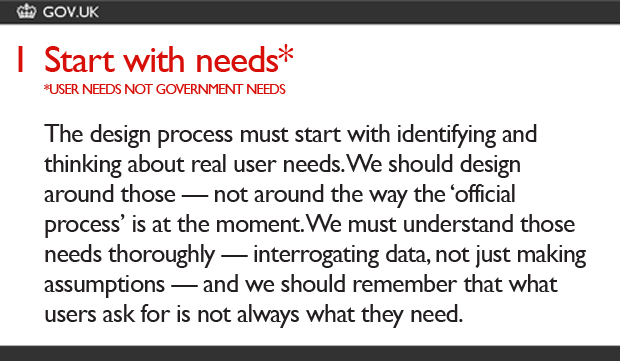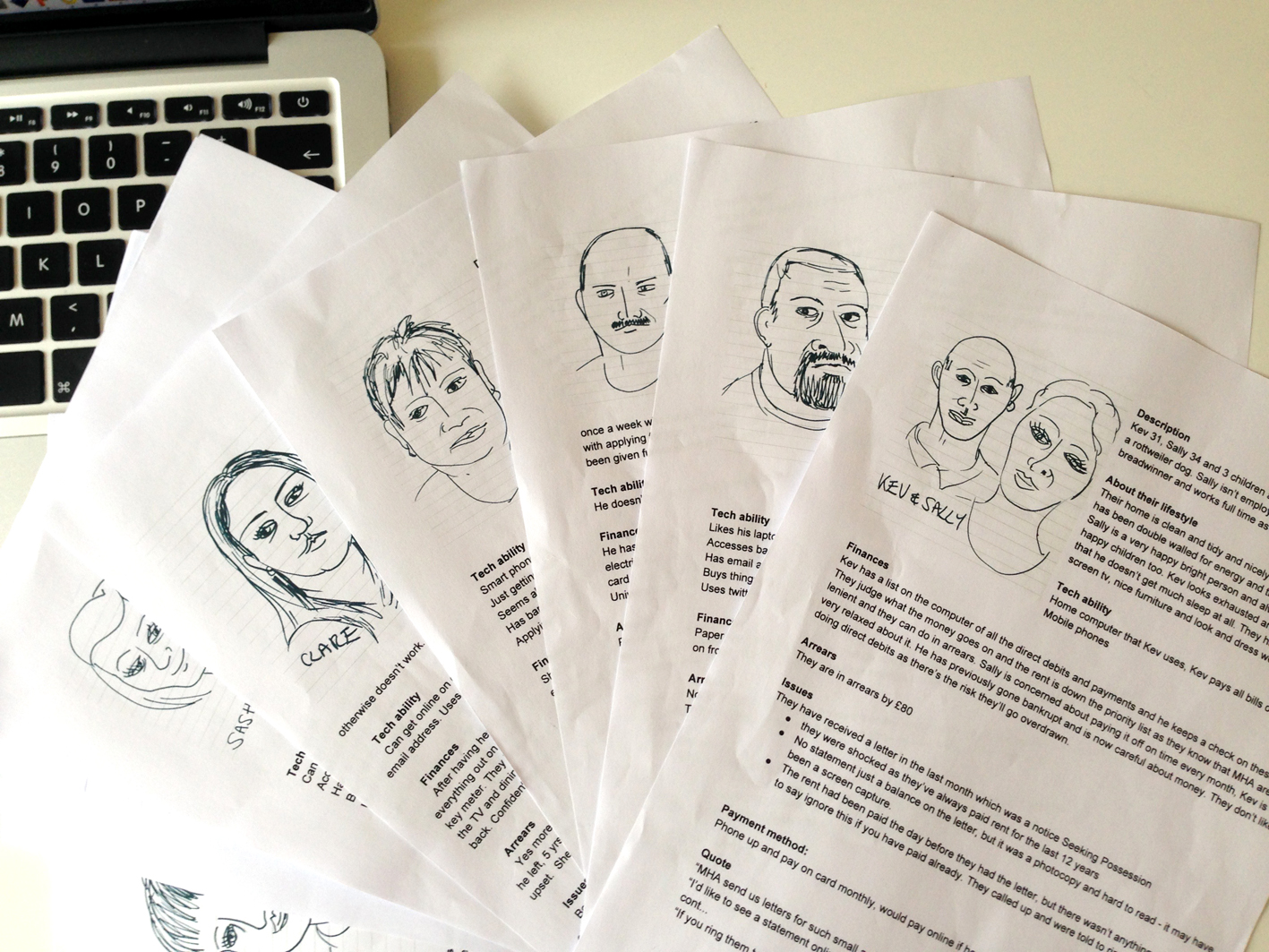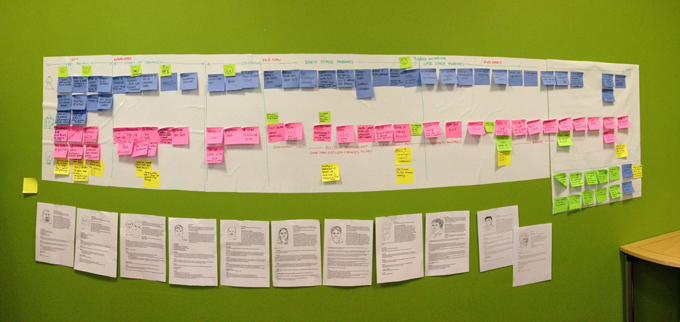Seeing your service through the eyes of your tenants can provide surprising insights and cost saving opportunities. Satori Lab applied user centred design tools with Monmouthshire Housing Association and were rewarded with a wealth of insights.
Many services are designed from the perspective of the organisation with only cursory consideration given to how this might look and feel from the customer’s point of view. The result is often poorly thought out services, wasted effort and inadequate systems and processes. How might we do better at this stuff?
One approach is to formally think about how your service is viewed by those who use it, and then do something about the insights you gain from a fresh perspective. This is known as user centred design - “designing services for user needs”. It sounds so obvious when you say it out loud, but honestly, how many of the services you deliver have actually been designed? More often services are cobbled together, tweaked and added to over the years as new policies come in and go out. Usually all done from the viewpoint of the organisation.
User Centred Design in the Private Sector

User centred design has been successfully implemented in the private sector. For example, Barclays decided to become the most design focused and technologically cutting-edge bank and now employ hundreds of service designers. Their Chief Design Officer says, “investing in design and focusing on improving customer experiences can lead to higher net promoter scores, which, in turn, drive higher income and reduce complaints, thereby lowering costs.”
Government is at this too….
Use of this sort of thinking isn’t confined to the private sector. The Government Digital Service (GDS) has a set of 9 design principles, the first of which is ‘Start with Needs - user needs, not government needs.’ If you’ve taxed your car recently in the UK, you will have experienced first hand the outcome of this approach - being able to tax your car online in a matter of seconds compared with traipsing to the Post Office with your insurance and MOT certificate, only to be confronted with a massive queue. GDS isn’t the only part of government using user centred design. Policy Lab, part of the Cabinet Office, is bringing new policy techniques to the UK Government, helping design services around people’s experience.

….and so are Social Housing providers
In housing, Thames Valley HA is building some great user-centric online customer services using this approach and the last two Service Design in Government Conferences (next on 9 - 11 March 2016) had numerous examples of this approach in housing and social services.
In Wales, Monmouthshire Housing Association used this approach in a recent review of their rent management system, which resulted in 53 ideas for service improvement - see case study.
Why do this?
This approach is used to design completely new services and improve existing. It can help you to identify bits of a service which are of no value to users, find things that block tenants from using digital over traditional services, and give you some truly insightful “aha” moments, such as ‘tenants in rent arrears don’t have a handle on the amount of their debt at any given time’. Once a problem is identified, it can result in significant cost savings and a seamless service which is much more aligned to tenant needs and expectations. Regular contact with users throughout the design period means that time and effort isn’t wasted creating services that don’t meet user needs.
If you’re looking to review one of your services, why wouldn’t you consider how it looks through the eyes of your service user - you might be surprised by some of the findings. Do contact jo@satorilab.org if you’re interested in exploring this in your own organisation or come and speak to me at Housing Camp Cymru on Saturday 14 November!
Case Study: Monmouthshire Housing Association Rent Management Review
The Satori Lab worked with Monmouthshire Housing Association (MHA) and, using tools from the designers toolkit, we set about helping them to review the rent management service by viewing the service from a user’s perspective.
Cheryl Tracy of MHA said:
“We were interested in this approach as we wanted to understand how our tenants experienced our service, rather than how we thought they experienced it. We were also clear that any meaningful review of our service needed to have tenants at the centre of it, and should be focused on improving the customer experience, ensuring that the service met their needs and expectations. Using this approach gave us valuable insights which would have otherwise been overlooked if it was entirely driven by staff and more traditional means of consultation.”
We started with the user and interviewed a number of tenants in their own homes - it was useful to do that in their own environment, making the interviewee feel at ease and allowing the interviewer to observe some of the behaviours and things which went unsaid. The tenants interviewed reflected the demographic of the users. Asking open questions, we collected information on their general circumstances before moving onto their experience of the rent collection service provided by MHA.
We used the data from the interviews to create fictitious personas of service users, which we then used in workshops with staff to help them get into the mindset of the service user and to move away from the idea that service users are an homogeneous group of people known as ‘tenants’.

We plotted the user journey with staff in workshops breaking it down to individual touchpoints (service interactions between service provider and customer) and considering it from multiple angles from front and back office actions to the emotional state of the tenant as a result of the interaction.
By breaking the service down like this, we were able to make visible things that previously were invisible. Staff highlighted the pain points and insights gathered from which the group came up with 53 recommendations for service improvement, 32 of which were “easy wins” and have been implemented and 10 of which are in the pipeline and some of which need prototyping.

The findings were broken down into ‘complacency about paying rent’ and ‘lack of understanding by tenants of their current rental balance’. Findings ranged from auto-texting the tenant on payment of their rent saying ‘thanks for your payment of £x, your new balance is £y’, to redesign of the rent statement and method of communicating the statement to tenants.
People like being “done with” rather than “done to” when it comes to organisational change and so these recommendations for service improvement, which came from staff themselves, have a far better likelihood of successful implementation.
Cheryl Tracy from MHA said:
“Feedback from staff and tenants involved in this service review has been overwhelmingly positive. The staff involved in the challenge workshops “didn’t realise how much of a journey they take their tenants on” and found it refreshing to view things entirely from the tenant's’ perspective. Using this approach really challenged our existing assumptions around what tenants might need and want from us, including how they want to engage with their landlord around paying their rent, (which will be particularly important with the implementation of Universal Credit and other welfare reforms). We would definitely use this approach again as it gave us a much more rounded view of our service and going forward it will have fundamentally changed the way we provide our rent management service to tenants.”
Contact jo@satorilab.org if you think we could help you in a similar way.
What is User Centred Design?
User-Centered Design (UCD) is a framework of processes for designing a product or service (not restricted to tech) from the perspective of how it will be understood and used by a human. It involves extensive user testing at each stage because it is understood that it is often very difficult for designers of a product or service to understand intuitively what a user experiences.
The result of employing UCD to a service is that it offers a more efficient, satisfying, and user-friendly experience for the user, which is likely to increase customer satisfaction and reduce costs.
Want to up your skills and knowledge?
Check out these FREE resources
Government Digital Service - Government Service Design Manual
This is developed with digital service delivery in mind, but the methods can be applied to other disciplines.
Policy Lab - Open Policy Making Toolkit
This toolkit is a practical guide bringing together the latest techniques to improve policy making. It draws mostly from the user centred designers toolkit and covers activities from creating personas of service users to how to run a hackday, including examples of best practice.
Stanford D. School - Bootcamp Bootleg
This document outlines each “mode” of a human centered design process, and then describes dozens of specific methods to do design work.
IDEO Designkit
A step-by-step guide to unleashing your creativity. The methods in this resource are really practical and cover the phases from inspiration to ideation to implementation.
Human Centred Design - FREE Online Course
This FREE online 7 week course starts again in Spring 2016 and is a great introduction to the concepts of human-centered design and how this approach can be used to create innovative, effective, and sustainable solutions for social change. No prior experience is required.
Service Design in Government - 3-day conference
This annual paid for conference is the place to be if you want to network with peers and leaders in the industry and pick up new ideas and skills to improve public services.
